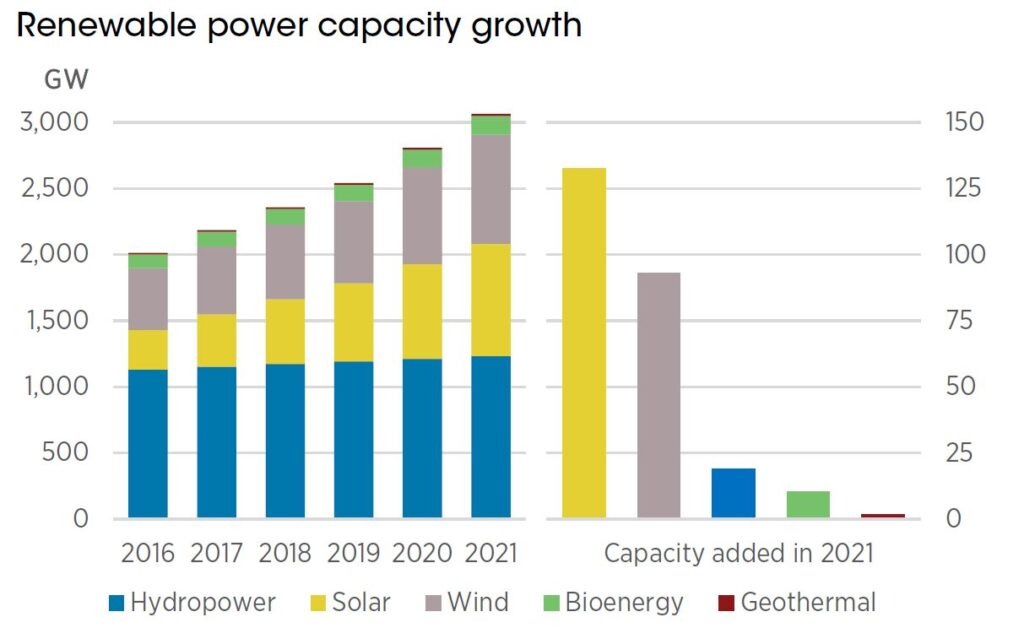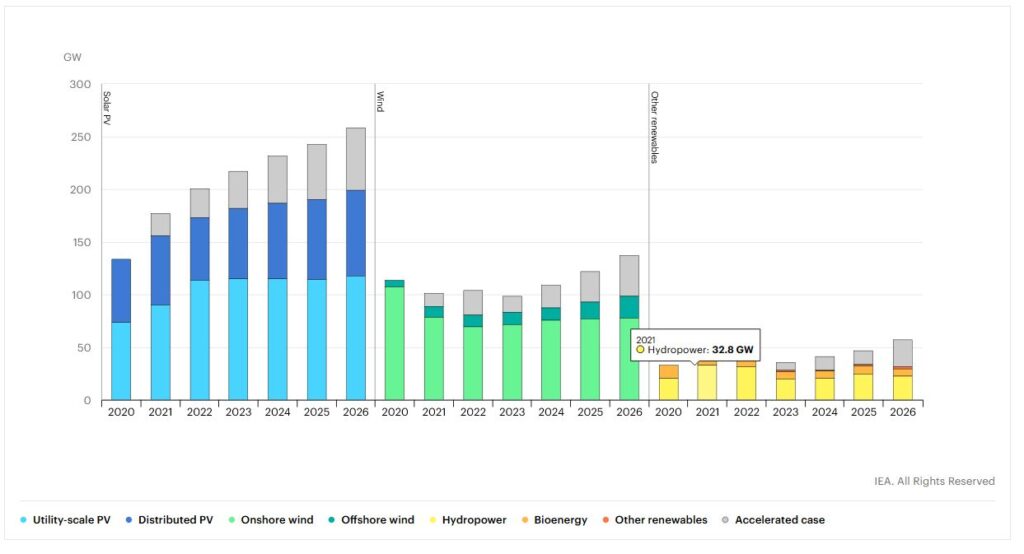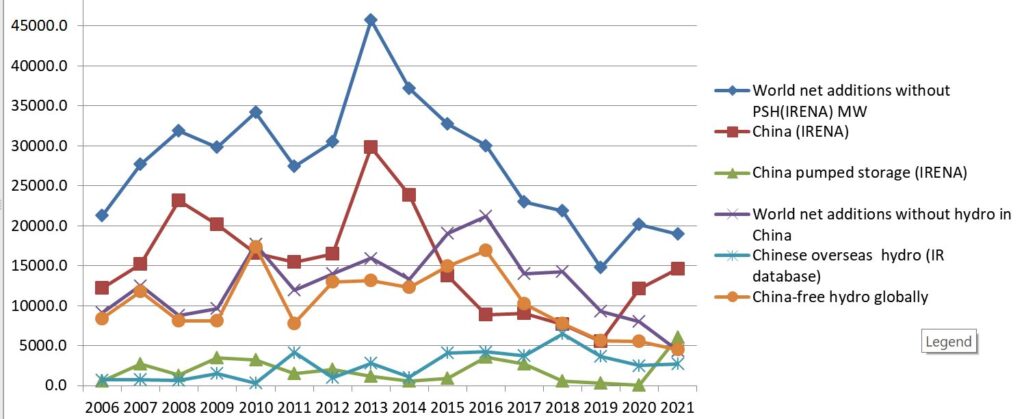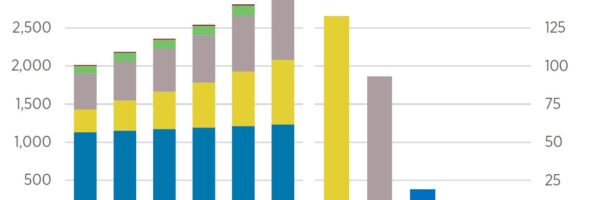
Source: https://www.irena.org/publications/2022/Apr/Renewable-Capacity-Statistics-2022
HYDRO-NO LONGER THE ENGINE FOR ENERGY TRANSITION
Hydropower net additions (without pumped storage) are preliminarily assessed in 2021 as 18.9 GW, which is only 7% of global growth in renewables estimated as 257 GW (roughly the same additions as in 2022). Hydropower has shown the slowest growth (2%) among all types of renewables (9% an average).

The International Energy Agency recently predicted that in the “main case” (without policy-driven acceleration) hydropower capacity addition will be highest in 2021-2022 (during the period before 2026) and will constitute 33 GW. In If we add to 19 GW of conventional hydro the 6 GW of pumped-storage hydro (PSH) installed in 2021 then overall addition will be still only 25 GW – one quarter or 8 GW short of the IEA forecast. But we must also note that mixing in one line PSH with conventional hydro is bad misleading statistics, for hydro is for electricity generation, while PSH is consuming energy to provide energy storage.
IRENA again vividly shows that significance of hydropower for energy transition continues to decline, despite hectic efforts of industrial lobby to promote its “decisive role in fighting climate change”. This is fully in line with IPCC report on mitigation issued in April 2022, which listed hydropower as having the least potential to reduce GHG emissions among all measures in energy industry in the period before 2030, when urgent action is needed. https://www.ipcc.ch/report/ar6/wg3/figures/summary-for-policymakers/figure-spm-7
ACTUAL PICTURE MORE CONTROVERSIAL
46 countries added some hydropower capacity in 2021, while in 9 countries capacity decreased. (similar numbers observed in 2020 ). Closer look at IRENA’s statistics shows that actual newly installed conventional hydropower (at country level) accounted for 23 GW, while reported decline in capacity have been almost 4.5 GW, most of it in USA and EU. This mysterious decline is 10 times more than country-level reductions in capacity reported in 2020. This means that despite declining “net additions”, in 2021 we see at least 3 GW more of new conventional hydro than in 2020. Of course, we do not know what part of new capacity comes from modernization of old existing dams, but it normally under 10% and list of countries with new additions makes us think that share is even lower. This, likely, year to year increase in new rivers destroyed for hydropower.

Source of data: https://www.irena.org/publications/2022/Apr/Renewable-Capacity-Statistics-2022
Detailed 2021 statistics looks as following (in MW):
| Decomissioned | – 4 364 |
| All installed | 29303.3 |
| Pumped Storage installed | 6400 |
| Hydro Installed | 22903 |
| Net addition | 18539 |
ROLE OF CHINA
China alone installed domestically 14.5 GW, mostly by completing several megadams in Yangtze Basin, which makes up 76% of net additions in 2021 (or 62% of actually installed hydro). This includes completion of the first high-altitude dam in Tibetan Plateau, where river valleys are essential refugia both for biodiversity and indigenous people.
In our preliminary estimate Chinese companies participated in installing at least 2700 GW in other countries of the world. This brings participation of Chinese companies to 90% of net hydropower capacity installed in 2021 ( or to 74% of all actually installed conventional hydropower).
THE REST OF THE HYDROPOWER WORLD
According to IRENA outside of China 8.7 GW of newly installed conventional hydro include the following countries contributing more than 100 MW. (CH marks countries where Chinese hydropower companies are known to be very active).:
Canada 1333 MW (mainly 834 MW Muskrat Falls Hydro –infamous for overspending, delay and alleged damage to indigenous communities)
Norway 1081 MW
India 800 MW
Lao DPR 767 MW (CH)
Viet Nam 765 MW (CH)
Nepal 690 MW (450MW Upper Tamakoshi finally commissioned after many years of delay and serious overspending) (CH)
Turkey 509 MW
Indonesia 461 MW (CH)
Guinea 450 MW –Souapiti Project likely not fully operational yet for lack of transmission to load centers) (CH)
Kazakhstan 248 MW (we can confirm only 25 MW at Turgusun Hydro) (CH)
Poland 187 MW
Zambia 150 MW (CH)
North Macedonia 138 MW
Georgia 116 MW (likely mistake in calculation of capacity for Shuakhevi Hydro built in 2014)
Brazil 108 MW (CH)
Accuracy of national reporting to IRENA differs from country to country. Presently the RwB cannot identify specific projects which went on-line in Laos, Vietnam, Norway, India and North Macedonia. We doubt accuracy of figures for Kazakhstan and Georgia. We also have no explanation for exceptionally high figures of decreae in capacity in the United states (3.8 GW). IRENA often makes corrections to its reports as more accurate information becomes available.
Pumped Storage Hydropower.
PSH is considered a promising way to store energy and regulate energy systems, but its development recently experienced serious setbacks. China has upgraded its policies to incentivize PSH and in 2021 commissioned 6 GW of pumped storage, which brings overall pumped storage capacity in China to 36GW. Ukraine, who comes next, installed 324 MW of pumped storage. Poland is listed as a country that lost 200 MW of PSH capacity in 2021. Globally net PSH addition in 2021 was 5992 MW. An average PSH is less destructive for river ecosystems and sometimes can be built without damming any natural streams (closed-loop design). However, built at wrong place (like Kanev PSH in Ukraine or Snowy-II in Australia) a pumped storage facility may incur as much negative impact as two conventional hydropower plants.
All in all slowing down of convention hydro development partly depends on incentives created for acquiring costly but reliable PSH technology, which is better suited for regulating modern energy systems.


